GAOS - Posttest - Health care providers
CDC and ATSDR Health Message Testing System
Attachment F_GAOS HCP Survey_1.24.20_FINAL POSTTEST
Assessment of Get Ahead of Sepsis Camplaign - Health Care Providers
OMB: 0920-0572
Get Ahead of Sepsis HCP Survey (GAOSHCPS) Form Approved
OMB Control No.: 0920-0572
Expiration Date 08/31/2021
Survey Section by Test Segment
-
Survey Section
Pretest
(n =30/TA)Posttest
Exposed
(n = 30/TA)
Unexposed
(n = 30/TA)
Unexposed
(n = Unlimited)Informed Consent
X
X
X
X
Screener
X
X
X
X
Exposure to Campaign
X
X
X
X
Frequency and Channel of Exposure
X
X
Knowledge
X
X
Attitudes & Beliefs
X
X
Behavior
X
X
Media Use and Habits
X
Demographic Characteristics
X
X
X
Target Audiences:
NPs/PAs at Urgent Care Clinics
ED Triage Nurses
PCPs
General Medical Ward Staff
Nurses in Long Term Care Settings
***************************************************
INFORMED CONSENT
Before beginning the survey, there are a few things you should know.
On behalf of the Centers for Disease Control and Prevention (CDC), the research firm ICF is conducting an online survey with healthcare professionals to gather feedback on educational materials related to sepsis. These materials were developed in partnership with the CDC, and we hope to use what we learn from these survey results to improve these materials and/or how and where we promote them to raise awareness within your community. We expect this survey to take about 20 minutes. You will only be asked to complete this survey once.
We want to learn from you, so we encourage you to answer honestly. There are no right or wrong answers. If you agree to participate in the survey, here are some points to know:
Rights Regarding Participation: Your participation in this survey is completely voluntary. You may choose to leave the survey and/or not answer a question at any time for any reason. Refusal to participate will involve no penalty or loss of benefits.
Privacy: We will take every precaution to protect your identity and ensure your privacy. We will keep your name and answers to these survey questions private. Your name and contact information will be kept separate from any survey responses. We will never use your name in any reports.
Benefits: Your participation in the survey will not result in any direct benefits to you. However, your input will help us to develop and improve educational materials about sepsis for people like you.
Risks: There is no known risk to you for your participation in the survey.
Incentive: In appreciation of your time and participation, the recruiter will give you a token of appreciation valued at $____ for participating in today’s survey.
Contact Information: If you have any questions about this survey or the campaign, please contact the research director, Kristen Cincotta, PhD, at 404-320-4433.
Do you agree to participate in the survey? Yes No
Programmer: If respondent selects Yes, please proceed to the survey.
If respondent selects No, display termination text.
Termination text: “Thank you for your time. Click here [insert URL] to exit this survey.”
SCREENER
The results of this survey will help the Centers for Disease Control and Prevention (CDC) refine and improve its ongoing campaign to improve antibiotic use. You will be asked to complete different versions of a survey depending on whether or not you have seen or heard certain messages from CDC about sepsis.
Programmer:
Include one question per page.
Screener should terminate as
soon as respondent selects an option that deems him/her ineligible.
May we ask you some questions to see if you are a good match to take this survey?
Programmer: If
“No,” TERMINATE.
If “Yes,” proceed to
Q2.
How old are you? _ _ years
Prefer not to answer [INELIGIBLE]
Programmer: If
18+ years, proceed to Q3.
If under 18 years, TERMINATE.
If
“Prefer not to answer,” TERMINATE.
In what ZIP code do you work? _____
Programmer: If
ZIP code is within the target areas, proceed to Q4.
If not
within the target area, TERMINATE.
Are you a healthcare professional (e.g., doctor, nurse, pharmacist, dietician, aid, sitter, social worker)
Yes
No [INELIGIBLE]
Programmer: If respondent selects “Yes” to Q4, proceed to Q5.
If respondent selects “No” or “Prefer not to answer” to Q4, TERMINATE.
What type of healthcare professional are you?? Please select all that apply.
Physician (MD or DO)
Nurse Practitioner (NP)
Physician Assistant (PA)
Registered Nurse (RN)
Licensed Professional Nurse (LPN)
Licensed Vocational Nurse (LVN)
Certified Medical Technician (CMT)
Certified Nursing Assistant (CNA)
Nurse Aide or Patient Sitter [INELIGIBLE]
None of the above [INELIGIBLE]
Prefer not to answer [INELIGIBLE]
In what type of setting do you work? (select all that apply)
Emergency room and/or department
Hospital
Urgent care medical clinic
Private practice
Community-based clinic or Federally Qualified Health Center
Managed care medical clinic (e.g., Kaiser)
Long-term care facility (e.g., nursing home, skilled nursing facility, long-term acute care center, adult daycare center, dementia facility)
None of the above [INELIGIBLE]
Prefer not to answer [INELIGIBLE]
Programmer: Categorize respondent.
Categorize respondent as “NPs/Pas at Urgent Care Clinics”
Q5 = NP or PA
Q6 = Urgent care medical clinic
Categorize respondent as “ED Triage Nurses”
Q5 = RN, LPN, or LVN
Q6 = Emergency room and/or department
Categorize respondent as “PCPs”
Q5 = Physician
Q6 = ANY
Categorize respondent as “General Medical Ward Staff”
Q5 = ANY
Q6 = Hospital
Categorize respondent as “Nurses in Long Term Care Settings”
Q5 = RN, LPN, or LVN
Q6 = Long-term care facility
Programmer: TERMINATION TEXT:
Thank you for your willingness to participate and answer our questions. Unfortunately, you do not meet the criteria to continue with the survey. If you have any questions about your participation and/or any questions about this survey, please contact the research director, Kristen Cincotta, Ph.D., at (404) 321-3211 or [email protected]. Thank you for your time.
Programmer: If ELIGIBLE, proceed with survey.
Thank you for answering the questions. We have determined that you are a good match for this survey. If you have any questions about your participation and/or any questions about this survey, please contact the research director, Kristen Cincotta, Ph.D., at (404) 321-3211 or [email protected].
EXPOSURE TO CAMPAIGN
Programmer: Include one question per page.
Now we would like to ask you about a CDC campaign to raise awareness about a medical condition called sepsis that you may or may not have seen or heard about in the past 2 months.
Please indicate below whether you have seen or heard any of following campaign names or slogans in the past 2 months.
Campaigns
Yes
No
Do not know
/cannot recallBe Smart. Beat Sepsis.
Be Sepsis Aware
Health is Precious. Don’t Get Sepsis.
Get Ahead of Sepsis
Know the Threat. Prevent Sepsis.
I
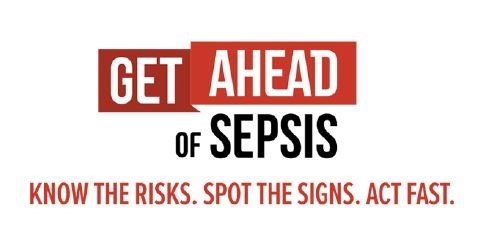 n
the past 2 months, did you see or hear this slogan and/or logo?
n
the past 2 months, did you see or hear this slogan and/or logo?
Yes
No
Do not recall
Programmer:
TERMINATION TEXT if INELIGIBLE:
“Thank you for your willingness to participate and answer our questions. Unfortunately, you do not meet the criteria to continue with the survey. If you have any questions about your participation and/or any questions about this survey, please contact the research director, Kristen Cincotta, Ph.D., at (404) 321-3211 or [email protected]. Thank you for your time.”
FOR POST TEST (INELIGIBLE) ONLY: “To learn more about sepsis, please visit https://www.cdc.gov/sepsis/.”
CLASSIFY:
If respondent selects “yes” for D for Q7 and/or
“Yes” or “Do not recall” for Q8, classify as
“Exposed” and continue to Frequency and Channel of
Exposure section.
If A, B, C, or E are selected for Q7
and “No” for Q8, classify as “Unexposed” and
continue to Media Use and Habits.
TERMINATE after securing 30 completed surveys for unexposed
individuals per target audience.
If ELIGIBLE, proceed with survey.
Thank you for answering the questions. We have determined that you are a good match for this survey. If you have any questions about your participation and/or any questions about this survey, please contact the research director, Kristen Cincotta, Ph.D., at (404) 321-3211 or [email protected].
Click “Continue to Survey” to begin the survey.
FREQUENCY AND CHANNEL OF EXPOSURE [POST-TEST, EXPOSED ONLY]
Programmer: Include one question per page.
You indicated that you had seen or heard the campaign name, Get Ahead of Sepsis, or seen the campaign logo in the past 2 months.
In the past 2 months, approximately how often did you see CDC’s Get Ahead of Sepsis campaign messages, campaign name, or logo in …?
PRINTED MEDIA
1-2 times a day
Once a week
1-3 times a month
Less than once a month
Never
Do not know/ cannot recall
Poster
Fact sheet
Brochure
Graphic
Newspaper/magazine advertisement
Flyer
Other print media
(please specify: _____________)
In the past 2 months, approximately how often did you see CDC’s Get Ahead of Sepsis campaign messages, campaign name, or logo in …?
SOCIAL MEDIA
1-2 times a day
Once a week
1-3 times a month
Less than once a month
Never
Do not know/ cannot recall
Facebook
Instagram
Twitter
LinkedIn
YouTube
Other social media
(please specify: _____________)
In the past 2 months, approximately how often did you see CDC’s Get Ahead of Sepsis campaign messages, campaign name, or logo in …?
ONLINE/INTERNET MEDIA
1-2 times a day
Once a week
1-3 times a month
Less than once a month
Never
Do not know/ cannot recall
Health websites /resources
Website advertisements
Online news articles
Streaming TV/video services (e.g., Hulu, Netflix, [Amazon] Prime Video)
Blogs
Advertisements on mobile phone (including mobile apps)
Search engines (e.g., Google)
Other websites (please specify: _____________)
In the past 2 months, approximately how often did you see CDC’s Get Ahead of Sepsis campaign messages, campaign name, or logo in …?
-
TV or RADIO
1-2 times a day
Once a week
1-3 times a month
Less than once a month
Never
Do not know/ cannot recall
Television (cable, satellite, or antenna)
Broadcast radio
Other media formats (please specify: _____________)
In the past 2 months, approximately how often did you see CDC’s Get Ahead of Sepsis campaign messages, campaign name, or logo in …?
-
PUBLIC PLACES
1-2 times a day
Once a week
1-3 times a month
Less than once a month
Never
Do not know/ cannot recall
Billboards
Bus, train, or subway stations
On buses or taxi cabs
Advertisement in a mall
Advertisement in a grocery store
Advertisement in a store pharmacy (e.g., CVS, Walgreens, Walmart)
Other public locations (please specify: _____________)
In the past 2 months, did you see CDC’s Get Ahead of Sepsis campaign messages, campaign name, or logo at work?
Yes, I personally placed or shared CDC’s Get Ahead of Sepsis campaign materials at my workplace in the past 2 months.
Yes, I saw CDC’s Get Ahead of Sepsis campaign at my workplace in the past 2 months, but I was not responsible for placing or sharing it.
No, but I saw materials from another sepsis campaign at my workplace in the past 2 months.
No, I have not seen any materials about sepsis at my workplace in the past 2 months.
Programmer: If respondent selects “Never” or “Don’t know/cannot recall” for ALL of the options in Q9-Q13 and either No option to Q14, reclassify these respondents as “Unexposed”, skip Q15, and proceed to “Media Use and Habits” section.
If respondent selects “1-2 times a day,” “Once a week,” “1-3 times a month,” or “Less than once a month” for any of the options in Q9-Q13, and either Yes option to Q14, proceed to Q15 and then “Knowledge” section.
In the past 2 months, where did you see CDC’s Get Ahead of Sepsis campaign messages, campaign name, or logo at your workplace? (select all that apply)
Posters or other print material(s) designed to educate patients about sepsis
Posters or other print material(s) designed to improve sepsis early recognition and timely treatment by healthcare professionals
Video displays in patient waiting areas
Workplace website or internal email/newsletter
Email or e-newsletter from external organization, such as a state or local public health agency or professional association
Other, please specify: ________________________
KNOWLEDGE [POST-TEST, EXPOSED ONLY]
Programmer: Include one question per page.
Thinking about your knowledge and awareness of sepsis, please indicate which statements you believe to be true.
About 1 in 3 patients who die in a hospital have sepsis.
TRUE
FALSE
More people die of heart attacks and strokes in one year than from sepsis.
TRUE
FALSE
Sepsis is defined as the following:
A chronic condition that mainly affects kidney function
A blood infection
The body’s extreme response to an infection
A neurological disorder resulting from the flu
Contagious illness that commonly peaks in the winter
All of the above
None of the above
Do not know
Almost any infection can lead to sepsis.
TRUE
FALSE
Which of the following types of infections, if any, are OFTEN linked with sepsis? (Select all that apply)
Ear
Skin
Lung
Eye
Urinary tract
Gut
All of the above
None of the above
Do not know
If your patient and/or resident is healthy, an infection isn’t anything you need to worry about.
TRUE
FALSE
Which of the following, if any, are the most frequently identified pathogens that cause infections that can develop into sepsis? (Select all that apply)
Staph
B. pertussis
H. pylori
E. coli
C. botulinum
Some types of Streptococcus
All of the above
None of the above
Do not know
Your fast recognition and treatment of sepsis can increase your patients’ chances of survival.
TRUE
FALSE
Check all the signs and symptoms of sepsis below:
Excessive thirst
Clammy or sweaty skin
Confusion or disorientation
Extreme pain or discomfort
Fever, shivering, or feeling very cold
High heart rate
Shortness of breath
I do not know any of the signs and symptoms of sepsis.
Only doctors need to know the existing guidance for diagnosing and managing sepsis at their facility.
TRUE
FALSE
Which of the following activities, if any, should you do and advise your patients and/or residents to do in order to prevent infections that can lead to sepsis? (Select all that apply)
Wash your hands regularly
Shower daily
Get recommended vaccines
Avoid public restrooms
Keep cuts and wounds clean and covered until healed
Take good care of chronic conditions
Ensure proper patient catheter removal (doctor nurse only)
All of the above
None of the above
Do not know
If you or your patients and/or residents suspect sepsis or have an infection that’s not getting better or is getting worse, you should discuss with them if the infection could be leading to sepsis.
TRUE
FALSE
Which of the following groups of individuals are at high risk for developing infections than can lead to sepsis, and sepsis? (Select all that apply)
Adults aged 65 and older
Children or adults with chronic conditions like diabetes, lung disease, cancer, and kidney disease
Children younger than 1 years old
Children or adults with weakened immune systems
Children or adults who have previously survived sepsis
All of the above. Anyone can get an infection.
Do not know
None of the above
Antibiotic therapy for patients who have developed sepsis should NOT be reassessed during the course of treatment.
TRUE
FALSE
Which of the following, if any, is true about sepsis? (Select all that apply)
Only people with chronic diseases are at risk for sepsis
Sepsis can cause tissue damage, organ failure, and death
Sepsis is a medical emergency
Timely treatment can increase the chances of survival
All of the above
None of the above
Do not know
Which of the following is true, if any, about what you should do if you suspect sepsis? (Select all that apply)
Alert the clinician in charge if it is not you
Start antibiotics as soon as possible, in addition to other therapies appropriate for the patient
Check patient progress frequently. Reassess antibiotic therapy in 24-48 hours to stop or adjust therapy if needed.
Identify and treat patients early
All of the above
None of the above
Do not know
ATTITUDES AND BELIEFS [POST-TEST, EXPOSED ONLY]
Programmer: Include one set of questions (e.g., perceived susceptibility, perceived severity) per page.
Next, we are going to ask you some questions to learn more about your perspective on infections and sepsis. Please give us your honest responses. There are no right or wrong answers to any of these questions.
Please indicate the extent to which you agree with the following statements, from strongly disagree to strongly agree.
-
[Perceived Susceptibility]
Strongly disagree
Disagree
Neutral
Agree
Strongly agree
My patients and/or residents are at risk of developing sepsis.
My patients and/or residents are at risk of developing infections that could lead to sepsis.
[Perceived Severity]
Strongly disagree
Disagree
Neutral
Agree
Strongly agree
If one of my patients and/or residents developed sepsis, it could cause severe problems such as tissue damage or organ failure.
If one of my patients and/or residents developed sepsis, it could lead to death.
[Perceived Benefits]
Strongly disagree
Disagree
Neutral
Agree
Strongly agree
If my patients and/or residents take proper care of their chronic conditions, this will decrease their chances of developing infections that can lead to sepsis.
If my patients and/or residents practice good hand hygiene, this will decrease their chances of developing infections that can lead to sepsis.
If my patients and/or residents keep their wounds clean and covered, this will decrease their chances of developing infections that can lead to sepsis.
If my patients and/or residents get recommended vaccinations, this will decrease their chances of developing infections that can lead to sepsis.
Timely treatment of infections can increase my patients’ and/or residents’ chances of survival from sepsis.
Recognizing signs and symptoms of sepsis early decreases my patients’ and/or residents’ risk of death from sepsis.
Acting fast if I suspect sepsis in my patients and/or residents can save lives.
[Self-Efficacy]
Strongly disagree
Disagree
Neutral
Agree
Strongly agree
I am confident that I can educate my patients and/or residents on how to prevent infections that can lead to sepsis.
I am confident that I can recognize the signs and symptoms of sepsis in my patients and/or residents.
I am confident that I can take rapid action to treat sepsis when suspected in patients.
BEHAVIOR [POST-TEST, EXPOSED ONLY]
Programmer: Include one question per page.
We’d like to know more about conversations you might have had with your patients and/or residents and their caregivers about sepsis.
Please indicate how frequently you discussed the following with your patients and/or residents and their caregivers in the past 2 months.
Behavior (Information Sharing with Patients, Residents, Caregivers)
Never
Rarely
Sometimes
Often
Always
N/A
The importance of taking care of chronic conditions.
The importance of regularly washing hands.
The importance of keeping wounds clean and covered until healed
The importance of getting the recommended vaccinations.
The importance of seeking immediate medical care if an infection is not getting better or is getting worse.
The importance of knowing the signs and symptoms of sepsis.
The importance of early recognition and timely treatment of sepsis.
The importance of preventing infections that can lead to sepsis
What are the barriers you commonly encounter when educating your patients and/or residents and their caregivers on preventing sepsis or on preventing infections that can lead to sepsis? Select all that apply.
I am not familiar enough with these topics.
I do not feel confident educating my patients/residents on these topics.
I do not think my patients/residents or their caregivers will understand these topics.
I do not think it is important for my patients/residents or their caregivers to understand these topics.
I do not think my patients/residents or their caregivers will be interested in or receptive to learning about these topics.
I do not have time to educate my patients/residents or their caregivers on these topics.
I do not think sepsis is a big problem for my patients and/or residents.
Other, please explain:___________
I have not encountered any barriers to educating my patients/residents or their caregivers on these topics.
I do not try to educate my patients/residents or their caregivers on preventing sepsis or on preventing infections that can lead to sepsis
Do not know/cannot recall
In the past 2 months, have you suspected that a patient and/or resident at your facility had sepsis?
Yes
No
Programmer: For respondents who checked “No” above to Q38, proceed to question 41.
For all other respondents, continue to Q39.
Please indicate how many patients and/or residents at your facility had sepsis in the past 2 months.
1
2
3
4
5 or more
Do not know
[Behavior - Act fast if sepsis is suspected] Please indicate how often you took the following steps for your sepsis patients in the past 2 months. (check all that apply)
Behavior (Act fast if sepsis is suspected) |
Never |
Rarely |
Sometimes |
Often |
Always |
N/A |
|
|
|
|
|
|
I am the clinician in charge of initiating treatment for these patients and/or residents |
|
|
|
|
|
|
|
|
|
|
|
|
|
|
[Behavioral Intention] I plan to take rapid action and initiate appropriate treatment when sepsis is suspected in my patients and/or residents.
Strongly disagree
Disagree
Neither agree nor disagree
Agree
Strongly agree
What are the barriers you experience to taking rapid action and initiating appropriate treatment when sepsis is suspected in your patients and/or residents? (choose all that apply)
I am not confident I can identify the signs and symptoms of sepsis.
I do not know how to alert the clinician in charge (it is not me).
I am not comfortable alerting the clinician in charge (it is not me).
It is not my role to identify sepsis and/or to alert the clinician in charge.
I do not have any barriers.
I have not had to take rapid action in my role.
Other. Please specify: ________________
[ALL HCPs] In the last 2 months, have you looked for information about infections that can lead to sepsis, or sepsis?
Yes
No
Do not know/cannot recall
Programmer: For respondents who checked “Yes” above to Q43, proceed to question 44.
For all other respondents, continue to Q45.
To whom or where do you go to learn about infections that can lead to sepsis, and/or sepsis? (select all that apply)
Colleagues, other HCPs
Centers for Disease Control and Prevention (CDC) website or material. Please specify: ____________________
Peer-reviewed journals (Printed or online). Please specify: ____________________
Health websites/health-related mobile apps (WebMD, Mayo Clinic, Medscape, UpToDate, etc.). Please specify: _____________________
Medical conferences. Please specify: __________________
Local/state health departments
Medical or professional associations. Please specify: _____________________
My place of work.
Continuing education/medical education/training courses (CE/CME, etc.). Please specify: __________________
Social media (Facebook, Instagram, Twitter, LinkedIn). Please specify: ______________________
Sepsis organizations (Sepsis Alliance, etc.). Please specify: __________________
Other. Please specify: _____________________
I have not looked for information on this topic.
Do you have Infection Prevention and Control (IPC) practices/guidelines at your facility?
Yes
No
Don’t know
Programmer:
If respondent selects Yes to Q45, proceed to Q46.
If
respondent selects No to Q45, skip Q46 and
proceed to Q47.
Do you know the content of the Infection Prevention and Control (IPC) practices/guidelines at your facility?
Do you have a sepsis protocol at your facility?
Yes
No
Don’t know
Programmer:
If respondent selects Yes to Q47, proceed to Q48.
If
respondent selects No to Q47, skip Q48 and
proceed to Q49.
Do you know the content of your facility’s sepsis protocol?
Did you know that the U.S. Centers for Disease Control and Prevention (CDC) has a Get Ahead of Sepsis webpage with resources you can use to help educate your patients about preventing infections that can lead to sepsis, and sepsis?
Programmer: FOR POST-TEST ONLY - If respondent selects Yes to Q49, proceed to Q50 (screen grab of below material and Q51 should be on one page).
If respondent selects No to Q49, skip to Demographic Characteristics section.
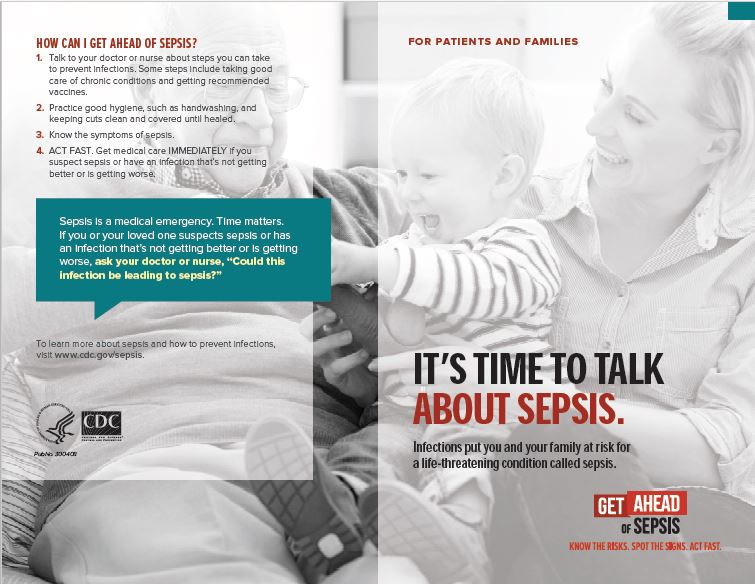
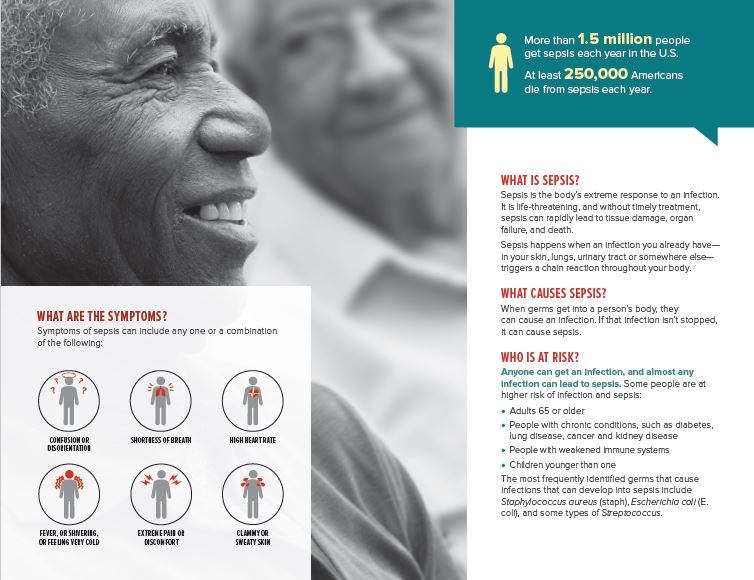
[It’s Time to Talk about Sepsis Brochure – 2 pages]
Please select how often in the past 2 months you used this brochure to educate your patients about sepsis?
I did not use this |
Rarely |
Sometimes |
Often |
Always |
Do not know |
|
|
|
|
|
|
Programmer:
If respondent selects Rarely, Sometimes, Often, Always,
or Do not know to Q50, proceed to Q51.
If respondent
selects I did not use this to Q50, skip Q51
and proceed to Q52.
How helpful for you was this brochure in educating your patients about sepsis?
Very helpful
Helpful
Somewhat helpful
A little helpful
Not at all helpful
Programmer: For Q51, proceed to Q52 regardless of answer choice (screen grab of below material and Q54 should be on one page)
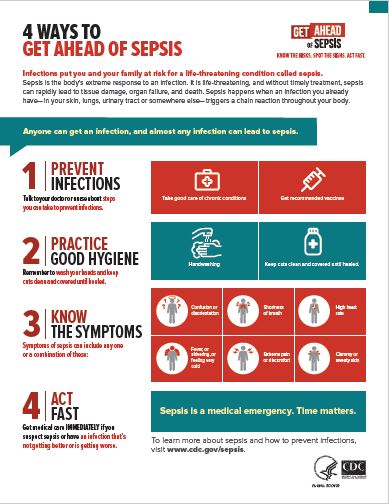
Four Ways to Get Ahead of Sepsis [1 page]
Please select how often in the past 2 months you used this fact sheet to educate your patients about how to get ahead of sepsis?
I did not use this |
Rarely |
Sometimes |
Often |
Always |
Do not know |
|
|
|
|
|
|
Programmer:
If respondent selects Rarely, Sometimes, Often, Always,
or Do not know to Q52, proceed to Q53.
If respondent
selects I did not use this to Q52, skip Q53
and proceed to Q54.
How helpful for you was this fact sheet in educating your patients about how to get ahead of sepsis?
Very helpful
Helpful
Somewhat helpful
A little helpful
Not at all helpful
Programmer: For Q53, proceed to Q54 regardless of answer choice (screen grab of below material and Q54 should be on one page)
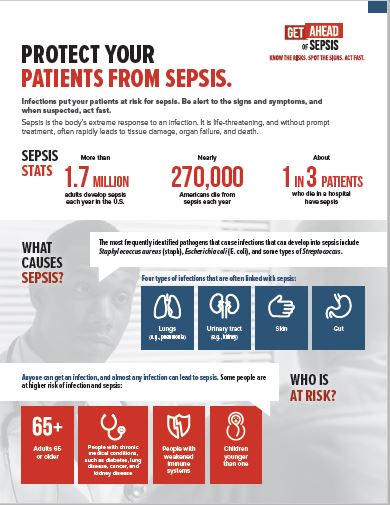
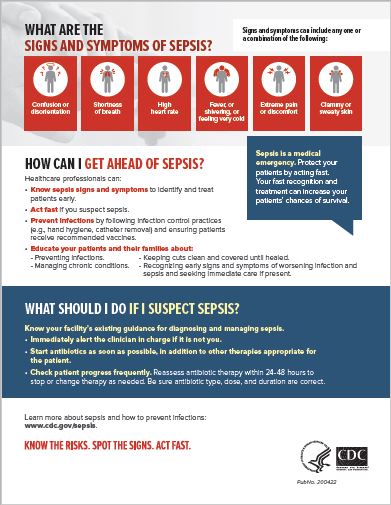
Protect Your Patients from Sepsis: Infographic [2 pages]
Please select how often in the past 2 months you used this fact sheet to educate yourself or your colleagues about sepsis?
I did not use this |
Rarely |
Sometimes |
Often |
Always |
Do not know |
|
|
|
|
|
|
Programmer:
If respondent selects Rarely, Sometimes, Often, Always,
or Do not know to Q54, proceed to Q55.
If respondent
selects I did not use this to Q54, skip Q55
and proceed to Q56.
How helpful for you was this fact sheet in educating yourself or your colleagues about sepsis?
Very helpful
Helpful
Somewhat helpful
A little helpful
Not at all helpful
Programmer: If respondent selects I did not use this to Q50, Q52, and Q54, continue to Q56. For all others, proceed to Demographics Characteristics section.
Why have you not used CDC Get Ahead of Sepsis resources to educate your patients about sepsis? (select all that apply)
I did use CDC Get Ahead of Sepsis resources to educate my patients, but they were not the ones shown above. (What resources did you use? (specify: __________________)
I do not usually use patient education resources when educating my patients on any topics
I/my organization has my/our own resources
I use resources developed by other organizations
I forget to use them
I do not have time to use them
I do not know where to find these resources
I looked at them, but did not find them helpful
I am not familiar enough with these resources to feel comfortable using them
Other (please specify: _______________)
Do not know
Programmer: Skip
to Demographic Characteristics section.
MEDIA USE AND HABITS [POST-TEST, UNEXPOSED ONLY]
Programmer:
Include one set of question (e.g., printed media, social media) per
page
Renumber items so that this section begins with Q10.
We would like to ask you a few questions about your media use and habits.
In an average month, how often do you…
PRINTED MEDIA |
1-2 times a day |
Once a week |
1-3 times a month |
Less than once a month |
Never |
Do not know/cannot recall |
Read printed magazines |
|
|
|
|
|
|
Read printed newspapers |
|
|
|
|
|
|
Read brochures or flyers on health topics |
|
|
|
|
|
|
Read other printed media (please specify: _____________) |
|
|
|
|
|
|
In an average month, how often do you…
SOCIAL MEDIA |
1-2 times a day |
Once a week |
1-3 times a month |
Less than once a month |
Never |
Do not know/cannot recall |
Use Facebook |
|
|
|
|
|
|
Use Instagram |
|
|
|
|
|
|
Use Twitter |
|
|
|
|
|
|
Use LinkedIn |
|
|
|
|
|
|
Use YouTube |
|
|
|
|
|
|
Use other social media (please specify: _____________) |
|
|
|
|
|
|
In an average month, how often do you…
ONLINE/INTERNET MEDIA |
1-2 times a day |
Once a week |
1-3 times a month |
Less than once a month |
Never |
Do not know/cannot recall |
Read health websites /resources |
|
|
|
|
|
|
Read news online |
|
|
|
|
|
|
Read magazines online |
|
|
|
|
|
|
Listen to internet radio |
|
|
|
|
|
|
Watch TV/movies using streaming services (e.g., Netflix, Hulu, [Amazon] Prime Video) |
|
|
|
|
|
|
Read blogs |
|
|
|
|
|
|
Use search engines (e.g., Google) |
|
|
|
|
|
|
Visit other websites (please specify: _____________) |
|
|
|
|
|
|
In an average month, how often do you…
TV or RADIO |
1-2 times a day |
Once a week |
1-3 times a month |
Less than once a month |
Never |
Do not know/cannot recall |
Watch television (cable, satellite, or antenna) |
|
|
|
|
|
|
Listen to broadcast radio |
|
|
|
|
|
|
Listen to satellite radio |
|
|
|
|
|
|
Watch or listen to other TV or radio media (please specify: _____________) |
|
|
|
|
|
|
In an average month, how often do you…
PUBLIC PLACES |
1-2 times a day |
Once a week |
1-3 times a month |
Less than once a month |
Never |
Do not know/cannot recall |
See billboards |
|
|
|
|
|
|
Use buses, subways, or trains |
|
|
|
|
|
|
Use taxi cabs |
|
|
|
|
|
|
Shop in malls |
|
|
|
|
|
|
Shop in grocery stores |
|
|
|
|
|
|
Shop in pharmacies (e.g., CVS, Walgreens, Walmart) |
|
|
|
|
|
|
Visit other public places (please specify: _____________) |
|
|
|
|
|
|
In an average month, how often do you…
OTHER MEDIA |
1-2 times a day |
Once a week |
1-3 times a month |
Less than once a month |
Never |
Do not know/cannot recall |
Read emails |
|
|
|
|
|
|
Read email newsletters |
|
|
|
|
|
|
Listen to webcasts or webinars |
|
|
|
|
|
|
Attend live events |
|
|
|
|
|
|
Use other media (please specify: _____________) |
|
|
|
|
|
|
To whom or where do you go to learn about infections that can lead to sepsis, and/or sepsis? (select all that apply)
Colleagues, other HCPs
Centers for Disease Control and Prevention (CDC) website or material. Please specify: ____________________
Peer-reviewed journals (Printed or online). Please specify: ____________________
Health websites/health-related mobile apps (WebMD, Mayo Clinic, Medscape, UpToDate, etc.). Please specify: _____________________
Medical conferences. Please specify: __________________
Local/state health departments
Medical or professional associations. Please specify: _____________________
My place of work.
Continuing education/medical education/training courses (CE/CME, etc.). Please specify: __________________
Social media (Facebook, Instagram, Twitter, LinkedIn). Please specify: ______________________
Sepsis organizations (Sepsis Alliance, etc.). Please specify: __________________
Other. Please specify: _____________________
I have not looked for information on this topic.
DEMOGRAPHIC CHARACTERISTICS
Programmer: Include one set of questions per page.
Thank you. Now we would like to know more about you.
How long have you worked in your current role/position?
Less than one year
1-5 years
6-9 years
10 or more years
Prefer not to answer
What is your sex?
Male
Female
Prefer not to answer
Do not know
How would you describe your racial background? Select all that apply.
White
Black or African American
Asian
Native Hawaiian or Other Pacific Islander
American Indian or Alaska Native
Other (please specify: _______________)
Prefer not to answer
Are you Hispanic or Latino?
Yes
No
Prefer not to answer
What is the highest degree you have received? (Please select only one)
High school Degree/GED
Associates Degree
Bachelors Degree
Masters degree
Professional degree (MD, JD, etc.)
Thank you for taking the time to participate in this important survey!
FOR POST TEST ONLY: To learn more about infection prevention and sepsis, please visit www.cdc.gov/sepsis.
Public reporting burden of this collection of information is estimated to average 20 minutes per response, including the time for reviewing instructions, searching existing data sources, gathering and maintaining the data needed, and completing and reviewing the collection of information. An agency may not conduct or sponsor, and a person is not required to respond to a collection of information unless it displays a currently valid OMB Control Number. Send comments regarding this burden estimate or any other aspect of this collection of information, including suggestions for reducing this burden to CDC/ATSDR Reports Clearance Officer, 1600 Clifton Road NE, MS D-74, Atlanta, Georgia 30333; ATTN: PRA 0920-0572.
| File Type | application/vnd.openxmlformats-officedocument.wordprocessingml.document |
| File Modified | 0000-00-00 |
| File Created | 0000-00-00 |
© 2026 OMB.report | Privacy Policy